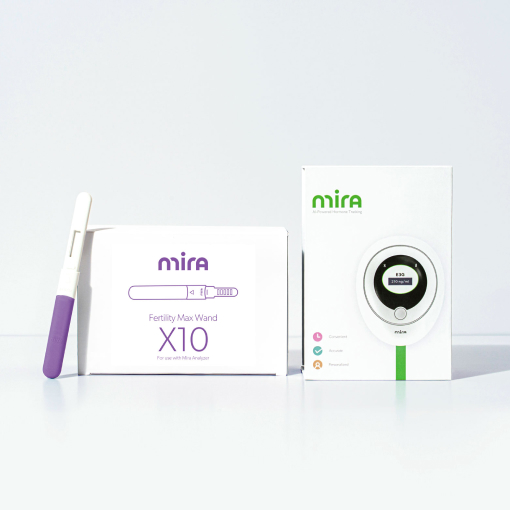A Guide to Low Progesterone: Symptoms, Causes & Treatments

Progesterone plays a critical role in your overall health and well-being so it’s no surprise that low progesterone can cause problems. Not only does progesterone regulate your menstrual cycle, but it’s the key building block of pregnancy and one of two major female sex hormones. The dynamic nature of this hormone can make it difficult to understand what’s normal since it plays a role in so many processes.
Hormonal imbalances can lead to a host of knock on health effects so in this article we’ll look at the signs and symptoms of low progesterone. From what progesterone is to what it does and what your levels should look like – we’ve got you covered in this guide to low progesterone symptoms. We’ll even look at some of the causes of low progesterone, how to increase progesterone and answer some common questions about progesterone levels (including testing!).
What is low progesterone?
Progesterone levels change over the course of your menstrual cycle so what is low progesterone? It can create a hormone imbalance that results in negative effects on a woman’s health since progesterone regulates your cycle, enhances mood, and supports several reproductive processes. Also, when progesterone levels are low, estrogen levels are too high in comparison, resulting in estrogen dominance.
Low progesterone can also cause abnormal uterine bleeding (in women who aren’t pregnant) and irregular or absent periods. If you don’t have enough progesterone in your system, you may have trouble getting and staying pregnant. Abnormal levels of progesterone can put your fertility and health at risk.
What are normal progesterone levels?
Progesterone levels range and fluctuate so what’s considered “normal” can depend on a number of factors including where you are in your cycle, stage of pregnancy, or even how old you are since we know progesterone may decline with age.
The following ranges are based on figures from the Mayo Clinic Laboratories and are measured in ng/mL, which is the measurement of progesterone levels in the blood.
Please note that Progesterone (measured in ng/mL) should not be confused with PdG (measured in ug/mL), the urine metabolite of progesterone commonly used in at-home testing. Mira tracks PdG. All the information provided in this article about Progesterone is purely educational. Please always refer to your healthcare provider.
If you are trying to conceive and have regular menstrual cycles, progesterone levels tend to stay below 0.89 ng/mL before rising to 1.8-24 ng/mL during ovulation and the luteal phase.

During pregnancy, progesterone levels can range depending on what stage of pregnancy you are at. Progesterone levels gradually rise throughout pregnancy, ranging from 11-44 ng/mL, 25-83 ng/mL, and 58-215 ng/mL during the first, second, and third trimesters, respectively.
After birth, progesterone levels fall back to their pre-pregnancy levels but it’s not an overnight process. It can take from four weeks to six months or longer for hormones to resume their normal patterns.
Please note that urine PdG should only be used for confirming ovulation. Mira Confirm Wands are not designed nor approved or cleared for monitoring early pregnancy status, miscarriage, fetal health tracking or other diagnostic uses for which progesterone might be an indicator.
How can you track your progesterone?
Until recently a blood test was the only way to measure progesterone levels and required a visit to your doctor as well as a lab to have your blood drawn. But progesterone levels can either be monitored via blood serum test or tracked through a test that measures for the metabolite of progesterone (pregnanediol glucuronide, or PdG) found in urine.
Blood serum tests only show your progesterone levels at one point in time, but we know that progesterone levels fluctuate day by day and even hour by hour. You would need multiple blood draws over the course of your cycle to get the average results of your progesterone levels.
You can test for the presence of progesterone in your body at home with PdG tests that test for the metabolized form of progesterone (PdG) in your urine. This lets you test for low PdG levels at home making it easier to track over time – providing you with more accurate insights about your ovulation patterns and fertility.
Causes of low progesterone
The causes of low progesterone can range and symptoms can result from a wide variety of causes. This hormone is mainly produced during ovulation so the most obvious cause is an issue with the ovaries but what causes low progesterone can vary depending on the person.
Hypothyroidism
When the body doesn’t produce enough thyroid hormones to maintain healthy function, the resulting condition is known as hypothyroidism. While the thyroid gland doesn’t directly produce progesterone, it is critical for regulating the entire endocrine system (the network of glands that produce hormones in the body). Hypothyroidism can impact progesterone levels by being unable to regulate hormone levels in the body which affects ovulation. If there is no ovulation, progesterone levels are predictably low.
Irregular cycle
Low progesterone levels can cause your menstrual cycle to become irregular, which in turn can prevent ovulation and disrupt your period. The primary function of progesterone is to help regulate the menstrual cycle so it makes sense that low levels could be caused by irregular cycles.
Menopause
As you age, progesterone naturally decreases to much lower levels than in your reproductive years. Menopause marks the end of ovulation and fertility so progesterone is no longer produced in the ovaries. The drop in hormones is what causes common physical symptoms of menopause such as hot flashes, fatigue, mood swings, and vaginal dryness. A small amount continues to be produced by the adrenal glands.
Miscarriage
Deficient levels of progesterone can prevent a fertilized egg from being implanted into the uterus. You need sufficient levels of progesterone to maintain your uterus until you give birth. Low levels of progesterone may lead to a miscarriage and you may be unable to carry the baby to term.
Low progesterone symptoms
Having low progesterone can cause a number of health complications including troubles getting and staying pregnant, headaches, hot flashes, night sweats, and vaginal dryness. If your progesterone levels are low, you might be experiencing uncomfortable symptoms as well as fertility issues.
Infertility
Progesterone primarily supports your body in getting pregnant and maintaining that pregnancy. So when levels of progesterone are too low, you may struggle to get pregnant. Progesterone is the building block of a healthy pregnancy and is commonly used as a fertility treatment. Without the necessary levels, you may experience infertility, or the inability to get pregnant after a year of regular and unprotected sex (less if you’re over 35).
Headaches
Hormonal changes often contribute to headaches, especially when it comes to progesterone. While it plays a key role in regulating the menstrual cycle, it can also affect headache-related chemicals in the brain. Not to mention, changes in estrogen related to progesterone levels, can cause vasodilation and water retention, both of which trigger headaches.
Hot flashes
Hot flashes are those sudden feelings of warmth and intense heat in the upper body. Your skin may redden as if you’re blushing and you may even break out into a sweat. They can be mild or intense but almost always are caused by hormonal imbalances. When progesterone is low, it can allow estrogen to become dominant by comparison and the imbalance can cause hot flashes.
Night sweats
Similar to hot flashes, night sweats can also be caused by changing hormone levels. Research suggests that hormonal imbalances cause your body’s thermostat to become more sensitive. When the thermostat thinks your body is too warm, it starts to sweat to cool you down, so even slight temperature changes can trigger the reaction whether it is necessary or not.
Vaginal dryness
Normal vaginal secretions are not only necessary but they are a key component of your sexual health. Vaginal dryness is a side effect of unbalanced hormones. When estrogen and progesterone are unbalanced or levels are off it can cause a host of problems that result in vaginal dryness. Stress, low libido, and mood changes can also result in a lack of sexual arousal and lubrication leading to vaginal dryness.
How to Increase Progesterone
Because progesterone is such a vital hormone, there are treatments available for low progesterone symptoms and supplementation is often necessary. Taking progesterone is risk-free and may help maintain pregnancies that would otherwise end in miscarriage. Progesterone is commonly used as a fertility treatment, and is widely recognized to treat a variety of issues from initiating menstruation to helping severe symptoms of PMS. See the common ways to increase progesterone below.
Creams
Creams and gels used to treat low progesterone can be used topically or vaginally depending on your goals. They work by applying the hormone directly to the skin where it can be quickly absorbed into your bloodstream. Progesterone creams are prescribed by your healthcare provider for specific health concerns like treating infertility or maintaining a pregnancy. Over the counter progesterone creams are widely marketed as a treatment for causes of low progesterone but they are not regulated by the U.S. Food and Drug Administration (FDA) and there are no set standards for their formulation.
Suppositories
Progesterone suppositories are a type of vaginal suppository that typically contains between 50-400 mg of progesterone. They are inserted into the vagina where the suppository will slowly release progesterone into the body where it can be absorbed into the bloodstream. In general they are harmless and do not cause potentially harmful side effects to you, your baby, or your partner. Some people experience side effects like vaginal irritation, dryness, or a yeast infection but serious side effects are rare. They should only be taken under the care and advice of your doctor and if you experience any serious or concerning side effects after taking a dose, you should consult with a medical professional immediately.
Oral medicines
Oral progesterone medication is a common way to treat signs of low progesterone especially by women who are undergoing menopausal hormonal therapy (MHT) due to menopause. It can also be used to treat women of reproductive age that experience amenorrhea (i.e. the absence of a period). It is widely used to initiate menstruation, help severe symptoms of PMS, and treat abnormal uterine bleeding. It is only available with a doctor’s prescription and should only be taken under the supervision of your doctor.
Low progesterone and pregnancy
Sufficient progesterone levels are essential to a successful pregnancy. You body needs a certain amount of progesterone to maintain your uterus until the baby is born and without proper supplementation, low progesterone can result in miscarriage or even fetal death. It is possible to have a successful pregnancy with low progesterone if you are taking supplementation or being treated for low progesterone.
During pregnancy, low progesterone levels may be a sign of miscarriage or ectopic pregnancy. And if your progesterone levels are too low, you are at a greater risk of miscarriage or pre-term delivery. There is a wide range of normal and levels can fluctuate based on when the reading was taken, but if your progesterone levels are too low during pregnancy, you are at a greater risk and your doctor may suggest various methods of treatment. If you are concerned at all you can ask your doctor how to increase your progesterone or take steps to raise your levels naturally.
Low progesterone FAQ
How common is low progesterone?
There are no exact numbers or statistics for how common low progesterone is but it is unfortunately all too common. And even though it has been well studied, there is still a lack of consensus among the scientific community about luteal phase defects caused by low progesterone. This can affect fertility but conflicting study results mean more research is needed in the area.
Due to testing, low progesterone has been notoriously difficult to diagnose but tracking your cycle and hormone levels is essential. To correctly track your cycle and luteal phase you need personalized feedback. The Mira analyzer is part of Mira’s advanced fertility tracking kit and measures LH levels in mIU/ML. This lets you see your exact hormone levels and the AI-powered app automatically charts everything to show your LH levels and surges.
How do you know if you have low progesterone?
Low progesterone levels can cause a number of symptoms such as irregular menstrual cycles and difficulties conceiving. The most common symptoms include irregular cycles, difficulties getting or staying pregnant, low libido, and/or frequent headaches or migraines.
Recommended for you
Navigate your fertility with peace of mind
Mira’s Editorial Process
All content produced by Mira meets stringent editorial standards, ensuring excellence and accuracy in language and medical precision. Every piece undergoes thorough fact-checking and review by qualified professionals. Check out our full editorial process to learn more.














